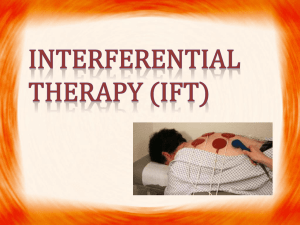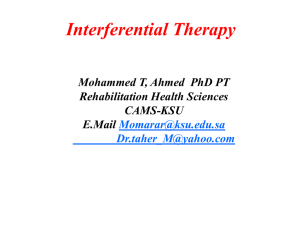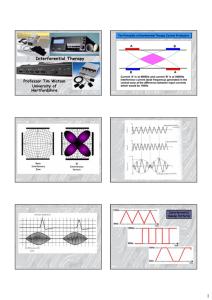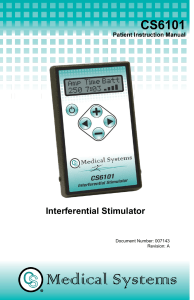CHIROPRACTIC PHYSIOLOGICAL THERAPEUTICS
advertisement
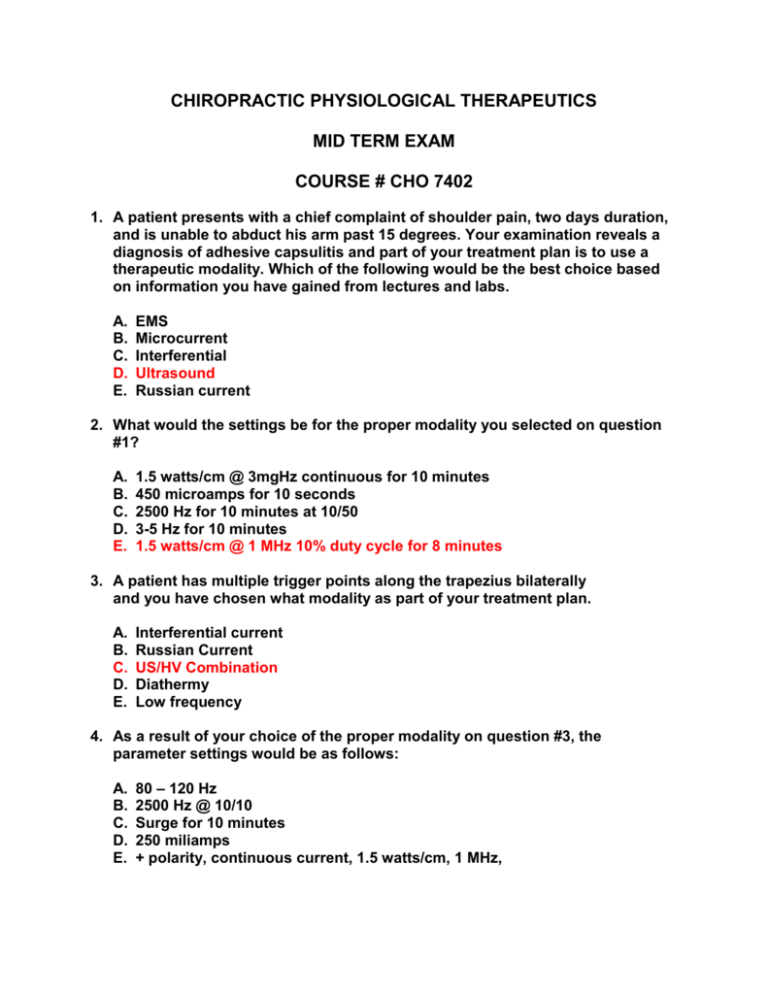
CHIROPRACTIC PHYSIOLOGICAL THERAPEUTICS MID TERM EXAM COURSE # CHO 7402 1. A patient presents with a chief complaint of shoulder pain, two days duration, and is unable to abduct his arm past 15 degrees. Your examination reveals a diagnosis of adhesive capsulitis and part of your treatment plan is to use a therapeutic modality. Which of the following would be the best choice based on information you have gained from lectures and labs. A. B. C. D. E. EMS Microcurrent Interferential Ultrasound Russian current 2. What would the settings be for the proper modality you selected on question #1? A. B. C. D. E. 1.5 watts/cm @ 3mgHz continuous for 10 minutes 450 microamps for 10 seconds 2500 Hz for 10 minutes at 10/50 3-5 Hz for 10 minutes 1.5 watts/cm @ 1 MHz 10% duty cycle for 8 minutes 3. A patient has multiple trigger points along the trapezius bilaterally and you have chosen what modality as part of your treatment plan. A. B. C. D. E. Interferential current Russian Current US/HV Combination Diathermy Low frequency 4. As a result of your choice of the proper modality on question #3, the parameter settings would be as follows: A. B. C. D. E. 80 – 120 Hz 2500 Hz @ 10/10 Surge for 10 minutes 250 miliamps + polarity, continuous current, 1.5 watts/cm, 1 MHz, Match the following: D 5. + polarity A. Ultrasound B 6. 10/10 setting B. Continuous current 7. Direct current C. 2500 Hz E 8. Nerve block D. Acute CD 9. 3-5 Hz E. 4000 Hz AB. High Voltage CD Chronic 10. The three modes of treatment used in Biphasic therapy are: A. B. C. D. E. Surge Normal Pulse Reciprocal Co-contraction 11. Frequency is the number of pulses that occur in one second. A. B. True False 12. The typical Monopolar application technique utilizes electrodes that is the same size. A. B. True False Match the following: A E 13. Tetany A. 1-15 Hz 14. Edema B. Subacute 15. Pain C. 15-30 pps 16. Copper Sulfate D. 80-120 Hz 17. Neg. polarity E. Chronic AB. Iontophoresis 18. In Interferential therapy, the “Beat frequency” in Hz is simply the difference in frequency between the two medium frequency currents. A. B. 19. Interferential pre-modulated bipolar application technique is best applied: A. B. C. D. 20. 10 – 15 minutes 20 – 30 minutes Contraindications to the use of Interferential therapy would Not include: A. B. C. D. 23. Electrodes of the same size and one output jack Electrodes of the same size and two output jacks Electrodes of different size and one output jack Electrodes of different size and two output jacks Interferential quadrapolar application to the lumbar spine, for the reduction of pain, average treatment time is: A. B. 22. To the Cervical region To the Thoracic region To the Wrist To the Lumbar region Interferential pre-modulated bipolar application technique uses: A. B. C. D. 21. True False Pacemakers Malignancy Metal objects Thrombosis The use of cold packs over electrodes is standard protocol when using electrical stimulators. A. B. True False Match the following: 24. Microcurrent A. Edema A 25. Ultrasound B. Trigger points E 26. Short-wave diathermy C. Myospasm B 27. High-voltage D. Acute Pain AB 28. Hot Moist Heat E. Upper Respiratory 29. Cold Packs AB Small region superficial 30. Combination US/HV 31. Interferential Current D 32. Russian Current C 33. Biphasic C 34. Combination US/Medium frequency 35. Microwave diathermy 36. High Voltage modalities are capable of producing Iontophoresis. A. B. 37. B E True False Galvanic stimulators utilize DC current A. B. 38. A True False In contrast to high voltage, low voltage offers a more comfortable current that is safer to use and more universal in its application. A. B. True False 39. Because of its high peak current and short pulse duration, penetration is not as deep when using high voltage current as compared to low voltage current. A. B. 40. When using high voltage current, the size of the dispersive electrode is recommended to be: A. B. C. 41. True False Low voltage therapy is primarily used for: (more than one answer) A. B. C. D. 45. True False In high voltage application treatment, choose the low pulse rate when treating acute conditions. A. B. 44. True False During high voltage treatment, the current flows in one direction. A. B. 43. The same size as the treatment electrode Double the area of the treatment electrode Smaller than the treatment electrode In high voltage application, The active electrode is connected to the lead output that is marked negative. A. B. 42. True False Pain Relief Edema reduction Muscle re-education Anesthetic areas In low voltage application the following techniques my be used. (more than one answer) A. B. C. Monopolar technique Bi-polar technique Quadrapolar technique. 46. In using low voltage treatment you would set the treatment mode to __?__ for reducing edema. A. B. C. 47. In using low voltage treatment you would set the treatment mode to ___?__ for breaking muscle spasm. A. B. C. 48. Pulse Surge Tetanize In using Iontophoresis, positive charged ions is driven into the tissues by the negative pole. A. B. 50. Pulse Surge Tetanize In using low voltage treatment you would set the treatment mode to __?__ for muscle re-education. A. B. C. 49. Pulse Surge Tetanize True False This one is on me. Mark A on your scantron.








